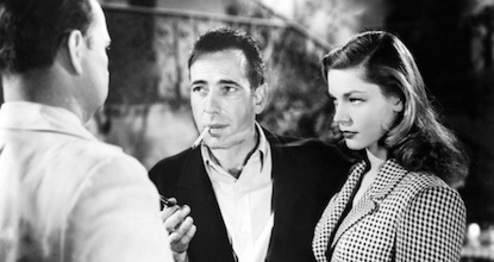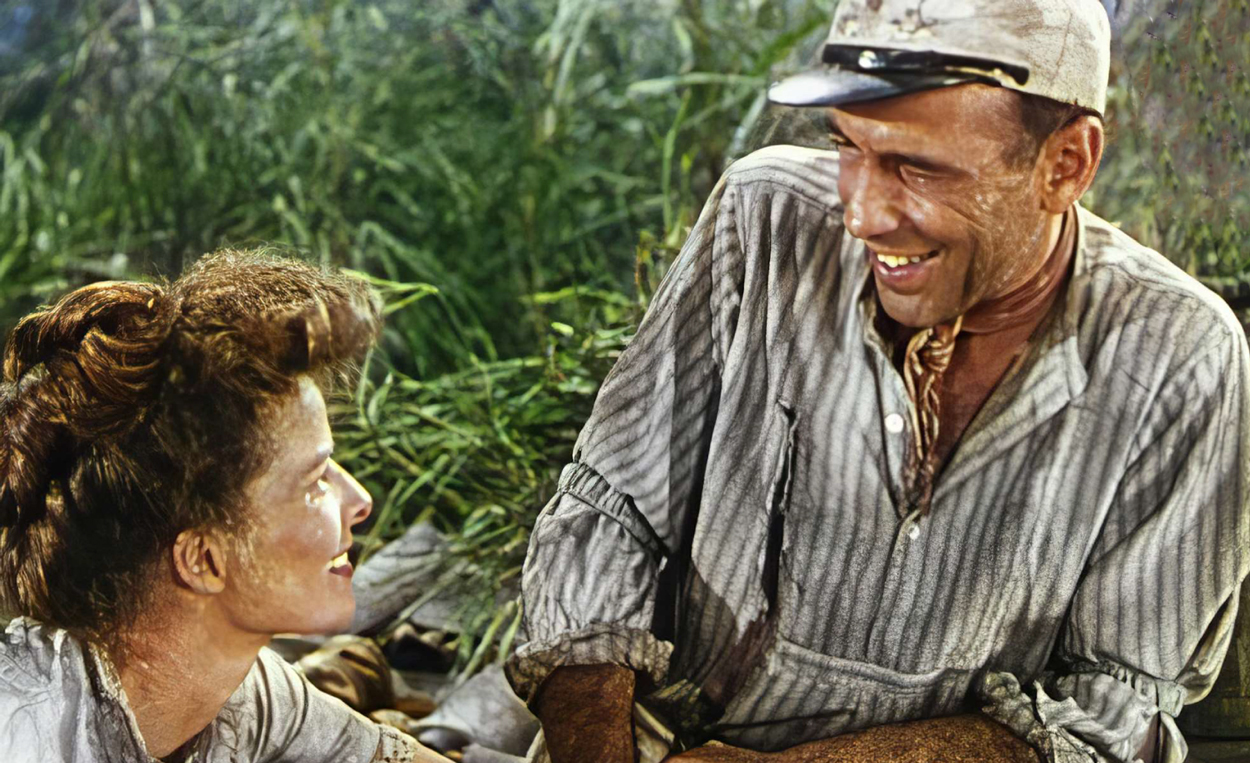It might be a push to call this documentary a feminist slant on Humphrey Bogart, but it wouldn’t quite be a shove. Northern Irish filmmaker Kathryn Ferguson’s work has often concerned itself with identity and gender politics, and her narrative here is framed around the women in Bogart’s life, starting with his aloof, undemonstrative mother, Maud.
Proper consideration is given to Bogart’s first three wives, Helen Mencken, Mary Philips, and Mayo Methot. In particular, Mayo is rescued from the cipher status to which many previous accounts of Bogart’s life assigned her: she was a former child star and beauty queen – the "Portland Rosebud", no less – an actress whose talent Bogie respected, and an important booster of his career. But Mayo had to watch as Bogart took a series of astonishing upward leaps – from High Sierra to The Maltese Falcon to Casablanca – while her career withered and her alcoholism prematurely aged her.
What jars a little, though, is the excision from the story of Verita Peterson, Bogart’s makeup artist and keeper of his toupées, with whom he had a passionate affair during his marriages to both Mayo and his fourth, final, and most famous wife, Lauren Bacall. The latter, who was 19 to Bogie’s 44 when they met, had her extramarital dalliances too, and we don’t hear anything about those.
Bogart’s daughter Leslie has always kept a low profile, and doesn’t appear here. His son, Stephen, clearly in control of this project on behalf of the Bogart Estate, does. We hear yet again the sad tale of Bogie and Bacall blithely flying off for six months with John Huston to make The African Queen in 1951, while Stephen, then two years old, was neglectfully left in care of nannies and grandparents. (Pictured below: Bogart and Bacall in To Have and Have Not)
 The need to toe the official line does sometimes lead to an unrealistically neat presentation of events. Bogie’s breakups with his first three wives are explained away by careerist drive, and are carefully compartmentalised, whereas in reality they often overlapped. Bogart was seeing Methot while still married to Philips, and would later cheat on her with Mencken.
The need to toe the official line does sometimes lead to an unrealistically neat presentation of events. Bogie’s breakups with his first three wives are explained away by careerist drive, and are carefully compartmentalised, whereas in reality they often overlapped. Bogart was seeing Methot while still married to Philips, and would later cheat on her with Mencken.
Still, this isn’t a bland hagiography. Bogart’s dark side is acknowledged, or at least some shades of it. He was a mean drunk who liked to needle people, sometimes to puncture pomposity, sometimes just for sheer sadism. On meeting Frank Sinatra, he said, “I hear you make little girls faint. Make me faint.” Sinatra, who idolised Bogie, took it well, and the two became fast friends, though that didn't stop Frank from romancing Bacall in Bogart’s house while Bogart lay dying of cancer upstairs.
Bogart’s late masterpiece In a Lonely Place is astutely highlighted as perhaps his most revealing role, the neurotic, misanthropic, hot-tempered screenwriter Dixon Steele sharing some Bogie traits and psychological idiosyncrasies. The dynamics between Bogart, Steele, director Nicholas Ray, and his then wife Gloria Grahame (who plays Bogart’s lover) are coiled and darkly complex and could fill an entire documentary on their own.
In fact, this might have worked better as a TV serial rather than a film. Bogart and Bacall’s courageous fight against the HUAC witch hunt would make a great episode. We’re given the standard narrative: naive but well-intentioned Hollywood liberals unwisely venturing out of their pampered Beverly Hills environment, receiving a salutary lesson in the fact that there is such a thing as bad publicity: “We went in green and they beat our brains out,” Bogart said.
Disappointingly, much weight is given to the fact that Bogart was pressured into making a mealy mouthed partial retraction, without mentioning that he refused to issue the statement his weaselly studio boss Jack Warner urged him to release, naming names and denouncing the Hollywood Ten. Anyway, the retraction had basically the same effect as a judge instructing a jury to ignore a revealing remark. Bogie was on the right side of history and then, as now, the media utterly failed to stand up to homegrown fascism. Bogart, by the way, would have blanched at the idea of hack actor Ronald Reagan as President, and would probably have a seizure at the sight of fascist toad Donald Trump. (Pictured below: Katharine Hepburn and Bogart in The African Queen)
 The documentary's 99-minute running time breezes by quickly, thanks to clever editing and narrative verve. (Shoutout, too, to Belfast’s David Holmes for the music.) The smooth-flowing surface is occasionally pierced with judiciously selected barbs, such as Louise Brooks’s assessment of Bacall: “as seductive as Eve, as cool as the serpent.”
The documentary's 99-minute running time breezes by quickly, thanks to clever editing and narrative verve. (Shoutout, too, to Belfast’s David Holmes for the music.) The smooth-flowing surface is occasionally pierced with judiciously selected barbs, such as Louise Brooks’s assessment of Bacall: “as seductive as Eve, as cool as the serpent.”
Bogart aficionados will enjoy matching films to clips: watch out for Sabrina, The Barefoot Contessa, and Bad Sister. Bogie newbies will surely be moved to investigate. There is home video footage, too, but it’s doled out parsimoniously. I’d have preferred much more of the Bogarts at home, abroad, and on Bogie’s yacht, the Santana. Also, is there a sinister international cabal that manufactures those awful "re-enactment" sequences and then blackmails filmmakers into using them?
The film begins and ends with Bogie’s funeral, and you’d need to have a heart of stone not to be moved by these sequences, particularly the skilfully handled ending. We see a parade of Hollywood stars in mourning, many of whom, such as Gary Cooper and Gregory Peck, were not particular friends of Bogart’s. Despite being an actor, which implies extroversion, Bogart the man could be something of a loner. He preferred the company of writers, and when he did have fellow actors as friends they tended to be complex, boozy, tormented types such as Spencer Tracy, not suave avatars of cool like Cooper.
Overall, Ferguson’s film does an admirable job of bringing some of Bogie’s indefinable but undeniable magic to the surface, where, like the California sunlight bouncing off the hull of his beloved yacht, it sparkles. This is the first proper, full-length documentary on one of the greatest and most fascinating stars of the Golden Age of Hollywood, and it does do him justice.














Add comment